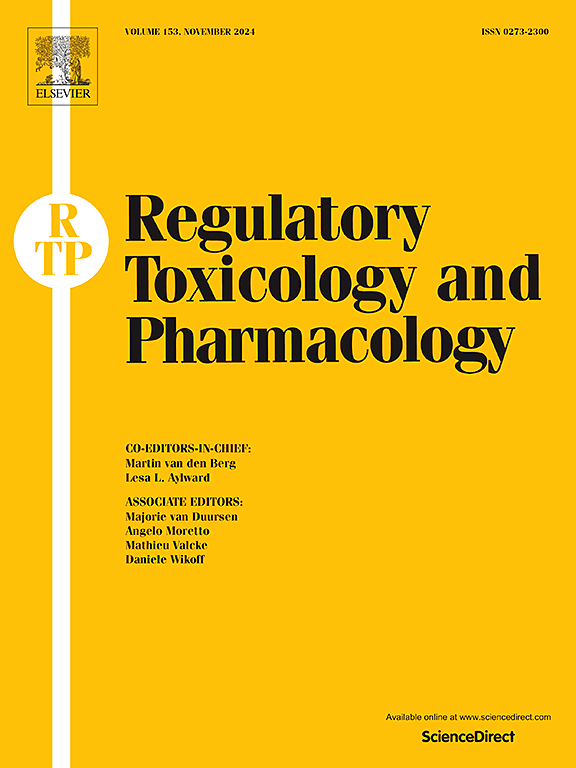针对 N-亚硝胺化合物的强化 Ames 试验条件,选择溶剂和阳性对照浓度
IF 3
4区 医学
Q1 MEDICINE, LEGAL
引用次数: 0
摘要
艾姆斯试验是一种广泛使用的细菌诱变性检测方法,用于评估化学物质诱发突变的可能性。近年来,人们越来越关注药品、食品和其他消费品中是否含有 N-亚硝胺。亚硝胺可能是诱变剂和致癌物质。为了解决亚硝胺(尤其是 N-亚硝基二甲胺)标准阿姆斯试验灵敏度降低的问题,欧洲药品管理局 (EMA) 和美国食品药品管理局 (FDA) 最近公布了关于增强型阿姆斯试验 (EAT) 条件的建议。然而,在选择 N-亚硝胺阳性对照浓度(尤其是 1-环戊基-4-亚硝基哌嗪)和 EAT 中使用的溶剂量方面缺乏明确的指导。本研究旨在解决目前在浓度和体积规范方面的空白,提供一份综合指南,指导如何使用适当的溶剂量、新溶剂和特定菌株的阳性对照浓度,专门针对 N-亚硝胺化合物建立增强型艾姆斯试验条件。本文章由计算机程序翻译,如有差异,请以英文原文为准。
Selection of solvent and positive control concentration for enhanced Ames test conditions for N-nitrosamine compounds
The Ames test is a widely used bacterial mutagenicity assay to evaluate the potential of chemical compounds to induce mutations. In recent years, there has been growing concern regarding the presence of N-nitrosamines in pharmaceuticals, food, and other consumer products. N-Nitrosamines are probable mutagens and carcinogens. To address the reduced sensitivity of the standard Ames test for N-nitrosamines, particularly N-nitrosodimethylamine, the European Medicines Agency (EMA) and United States Food and Drug Administration (FDA) have recently published recommendations for enhanced Ames test (EAT) conditions. However, there is a lack of clear guidance on the selection of N-nitrosamine positive control concentrations, particularly for 1-cyclopentyl-4-nitrosopiperazine, and the amount of solvent to be used in the EAT. This study aims to address the current gap in concentration and volume specifications by providing a comprehensive guide to set up enhanced Ames test conditions specifically for N-nitrosamine compounds using appropriate amounts of solvent, new solvents, and strain-specific positive control concentrations.
求助全文
通过发布文献求助,成功后即可免费获取论文全文。
去求助
来源期刊
CiteScore
6.70
自引率
8.80%
发文量
147
审稿时长
58 days
期刊介绍:
Regulatory Toxicology and Pharmacology publishes peer reviewed articles that involve the generation, evaluation, and interpretation of experimental animal and human data that are of direct importance and relevance for regulatory authorities with respect to toxicological and pharmacological regulations in society. All peer-reviewed articles that are published should be devoted to improve the protection of human health and environment. Reviews and discussions are welcomed that address legal and/or regulatory decisions with respect to risk assessment and management of toxicological and pharmacological compounds on a scientific basis. It addresses an international readership of scientists, risk assessors and managers, and other professionals active in the field of human and environmental health.
Types of peer-reviewed articles published:
-Original research articles of relevance for regulatory aspects covering aspects including, but not limited to:
1.Factors influencing human sensitivity
2.Exposure science related to risk assessment
3.Alternative toxicological test methods
4.Frameworks for evaluation and integration of data in regulatory evaluations
5.Harmonization across regulatory agencies
6.Read-across methods and evaluations
-Contemporary Reviews on policy related Research issues
-Letters to the Editor
-Guest Editorials (by Invitation)

 求助内容:
求助内容: 应助结果提醒方式:
应助结果提醒方式:


